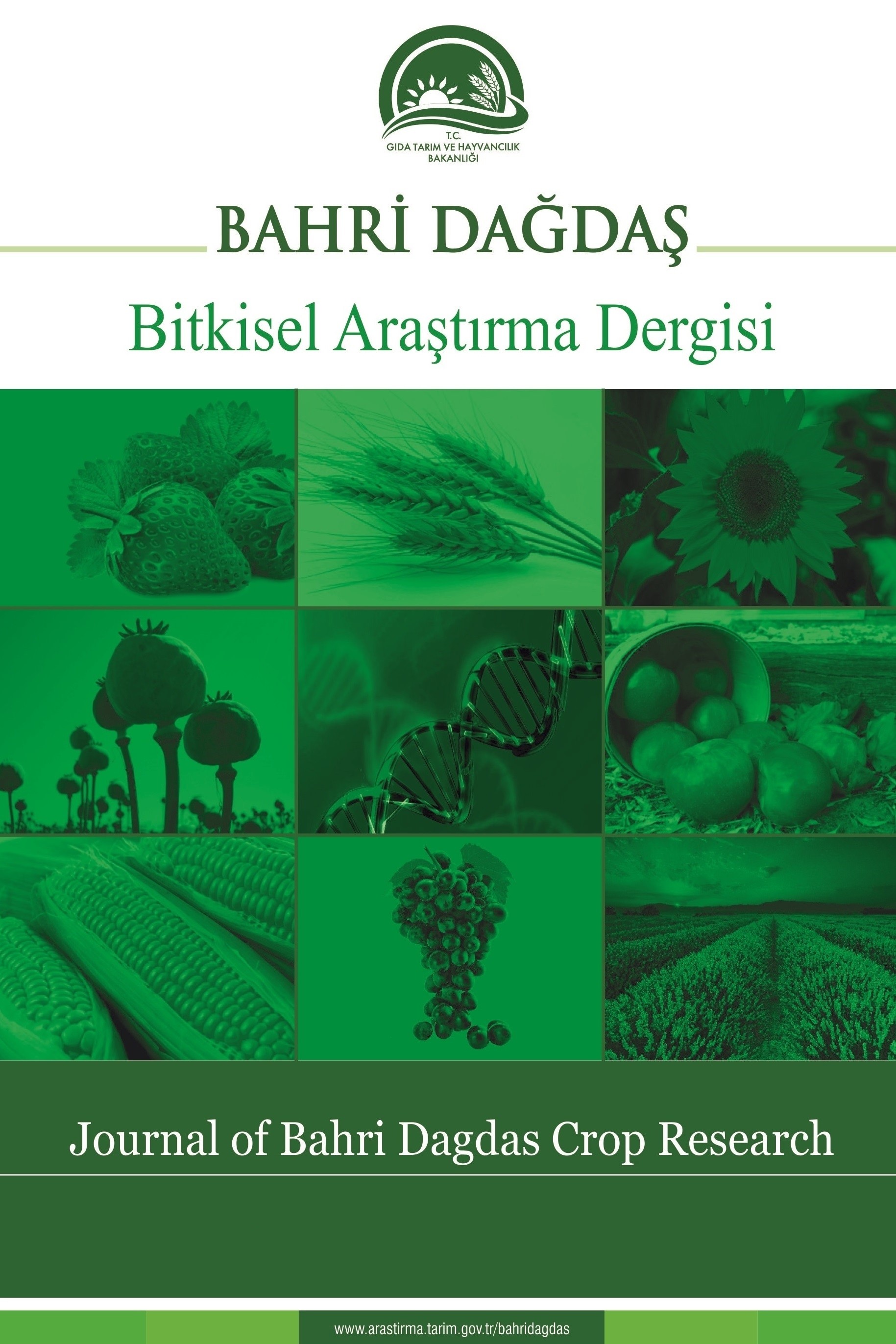Domateste Öz Nekrozu Etmenlerinden Pseudomonas cichorii ve Pseudomonas corrugata’nın ELISA’ya Dayalı ve Geleneksel Tanı Yöntemleri ile Teşhisi
Domates öz nekrozuna neden olan bakteriyel etmenler Pseudomonas cichorii and Pseudomonas corrugata dünyada domates üretiminin yapıldığı yerlerde önemli kayıplara sebep olabilmektedir. P. cichorii and P. corrugata Türkiye’de Akdeniz Bölgesi’nde üretimi yapılan domateslerde tespit edilmiştir. Mersin ve Adana illerindeki sera domateslerinde, patojenlerin neden olduğu hastalığın simptomları solgunluk, bitki gövdesi üzerinde koyu renkte lekeler ve bitki özünde koflaşma ile karakterize edilmiştir. Bu çalışmada, simptom gösteren bitkilerden elde edilen bakteriyel izolatların tanısı geleneksel ve ELISA (Enzyme-Linked ImmunoSorbent Assay)’ya dayalı tanı yöntemleri kullanılarak yapılmıştır. Test sonuçlarına göre 15 adet izolat P. cichorii, 1 adet izolat P. corrugata olarak tanılanmıştır. Her iki patojenin teşhisinde, geleneksel tanı testlerinin yanı sıra, saf bakteri kültürü kullanılarak yapılan indirekt-ELISA metodu hızlı sonuç veren duyarlı, güvenilir metot olarak değerlendirilmiştir
Anahtar Kelimeler:
P. cichorii, P. corrugata, geleneksel, indirekt-ELISA, tanı
ELISA-based and Traditional Diagnosis Methods for Identification of Pseudomonas cichorii and Pseudomonas corrugata Causing Pith Necrosis on Tomato Plants
Pseudomonas cichorii and Pseudomonas corrugata, the causal bacterial agents of tomato pith necrosis, may cause severe losses on tomato worldwide. In Turkey, P. cichorii and P. corrugata were observed on tomato in the Mediterranean Region. The typical disease symptoms of pathogens were characterized as wilting, dark blotches on tomato stems, browning and hollowing of pith in greenhouse tomato plants in Adana and Mersin provinces. In this study, traditional and ELISA (Enzyme-Linked ImmunoSorbent Assay)-based methods were performed for identification of isolates obtained from symptoms showing plants. In total, 15 of P. cichorii isolates and 1 of P. corrugata isolate were identified according to the diagnostic tests. In addition to traditional diagnosis methods, Indirect-ELISA that was made with pure bacterial cultures was evaluated as capable and reliable diagnosis method of rapid resulting for both pathogenic bacteria
Keywords:
P. cichorii, P. corrugata, traditional, indirect-ELISA, diagnosis,
___
- Aysan, Y., Yıldız (Yonucu), N., Ülke, G., Çınar, Ö., Yücel, F., Yıldız (Çetinkaya), R., (2002). Doğu Akdeniz Bölgesi Domates seralarında gövde nekrozuna neden olan bakteriyel hastalık etmenlerinin saptanması, epidemiyolojileri ve entegre mücadelesi üzerine araştırmalar. TARP-2364 nolu projenin sonuç raporu. 126 s. Adana
- Catara, V., Gardan L. Lopez, M. M. (1997). Phenotypic heterogeneity of Pseudomonas corrugata strains from southern Italy. Journal of Applied Microbiology 83: 576-586
- Cirvilleri, G., Bella, P., La Rosa, R., Catara, V. (2008). Internalization and survival of Pseudomonas corrugata from flowers to fruits and seeds of tomato plants. In book: In: MB. FATMI ET AL., "Pseudomonas syringae Pathovars and Related Pathogens-Identification, Epidemiology and Genomics"., Editors: EDS.SPRINGER, pp.73-79
- Demir, G. (1990). The occurrence of Pseudomonas corrugata on tomatoes in Turkey. Journal of Turkish Phytopathology 19: 63-70
- Demir, G., Gündoğdu, M. (1988). The bacterial disease of tomato caused by Pseudomonas cichorii in Turkey. In: 5th Turkish Phytopathological Congress, October 18-21, Antalya
- EPPO, (1992). Quarantine Procedure: Clavibacter michiganensis subsp. michiganensis. Test methods for tomato seeds. EPPO Bulletin, 22 (2): 219-224
- Fiori, di M., Carta, C., Franceschini A., (1983). II Saggio Immunoenzimatico (ELISA) per la Diagnosi Precoce e Rapida Della Necrosi del Midollo di Pomodoro da Pseudomonas corrugata Roberts et Scarlett. Phytopathologia Mediterranea 22: 22-26
- Gouk, S. C., Noonan, M. J., Musgrave, D. R. (1989) Identification of Pseudomonas cichorii by enzyme linked immunosorbent assay (ELISA). Proc. 7th Int. Conf. Plant Pathology and Bacteriology (Budapest, Hungary), pp. 877-887
- Janse, J. D. (1987). Biology of Pseudomonas cichorii in chrysanthemum. EPPO Bulletin, 17: 321-323.
- Lelliot, R. A., Stead, D. E. (1987). Media and methods. in: Methods for the Diagnosis of Bacterial Diseases of Plants. Blackwell Scientific Publications Inc., Oxford, UK. pp. 169-199
- Lopez, M. M., Siveria, F., Albiach, M. R., Garsia, F., Rodriguez, R. (1994). Characterizaiton of Spanish Isolates of Pseudomonas corrugata from Tomato and Pepper. Plant pathology 43: 80-90
- McLaughlin, R. J., Chen, T. A. (1990). ELISA methods for plant pathogenic prokaryotes. In: Serological methods for detection and identification of viral and bacterial plant pathogens (Edts. Hampton, R., Ball, E., and DeBoer, S.). APS Press The American Phytopathological Society St. Paul Minnesota, USA, pp. 197-204
- Rowhani, A., Feliciano, A. J., Lips, T., Gubler, D. (1994). Rapid identification of Xanthomonas fragariae in infected strawberry leaves by enzyme-linked immunosorbent assay. Plant Dis. 78:248-250
- Scarlett, C. A., Fletcher J. T., Roberts, P., Lelliott R. A. (1978). Tomato pith necrosis cause by Pseudomonas corrugata. Annals of Applied Biology 88: 105-114
- Siverio, F., Cambra, M. T., Corzo J., Lopez M. M. (1993). Lipopolysaccharides as determinants of serological variability in Pseudomonas corrugata. Applied and Environmental Microbiology 59: 1805- 1812
- Swingle, D. B., (1925). Center rot of “French endive” or wilt of chicory (Cichorium intybus). Phytopathology 15: 730
- Wilkie, J. P., Dye, D. W. (1974). Pseudomonas cichorii causing tomato and celery diseases in New Zealand Journal of Agricultural Research 17: 123-130
- ISSN: 2148-3205
- Yayın Aralığı: Yılda 2 Sayı
- Yayıncı: Bahri Dağdaş Uluslararası Tarımsal Araştırma Enstitüsü
Sayıdaki Diğer Makaleler
Seydi AYDOĞAN, Mehmet ŞAHİN, Aysun GÖÇMEN AKÇACIK, Sümerya HAMZAOĞLU, Seyfi TANER
Makarnalık Buğday Islah Materyalinin Miksograf Parametreleri ile Değerlendirilmesi
Mehmet ŞAHİN, Aysun GÖÇMEN AKÇACIK, Seydi AYDOĞAN, Sümerya HAMZAOĞLU, Musa TÜRKÖZ
Farklı Yüzey Aktif Maddelerin Domatesin Gelişimine Etkileri
